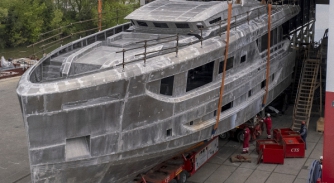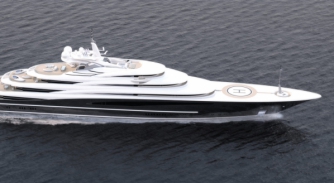Navigating shipyard insolvency during superyacht builds
Wikborg Rein's Linda Roxburgh discusses safeguarding superyacht owners' interests if their shipyard faces financial instability mid-build…

In an exclusive article for SuperyachtNews, Linda Roxburgh, Legal Director at Wikborg Rein, carefully navigates the best ways to safeguard a superyacht owner’s interests if the shipyard managing their project should become financially unstable mid-build.
While the cases of shipyards suddenly declaring financial distress mid-build are thankfully rare, when this does occur the consequences for owners can be extreme. In the intricate world of superyacht construction, the financial stability of shipyards is rarely a top priority for owners when selecting a project partner to construct their dream yacht. In my experience, shipyards are largely chosen based on previous experience, reputation, recommendation, price, after-sales service, customisation, and/or available time slots — all of which are excellent selection criteria for a project partner.
However, recent incidents of shipyard turmoil have highlighted that when things go wrong, they can really go wrong. Projects can suddenly stall mid-build, staff can be out of work, the partially-completed yacht could be seized by insolvency administrators, and if this happens, there is often little the owner can do about it, and there is little prospect of recouping the money paid in advance of delivery. The situation continues downhill fairly rapidly from there.
Roll the tape back, however, and there are both preventative measures and reactive strategies that owners can consider to safeguard their projects, even if the worst should happen to the yard.
Proactive mitigation strategies
Shipyards typically operate on relatively narrow margins, making them vulnerable to sudden unforeseen events such as supply chain disruption, rises in the cost of materials, and government actions such as the lockdowns. If a yard suddenly declares it has financial problems, owners have a few options available to them, such as:
● Making a loan to the distressed yard
Providing a loan can alleviate the yard’s immediate cash flow problems, potentially allowing project completion. In these cases, an owner should, if possible, obtain security for any loan, ring-fence it to ensure funds are only allocated to that specific build and not to anything else, and carefully monitor the yard's application of the funds provided. It is also essential to assess the likelihood of repayment. The yard’s transparency and cooperation in agreeing the loan terms are crucial to take into account when considering this. Alternatively, the owner might be prepared to write off the loan as an additional cost to get the project completed, with any repayment considered a happy bonus.
● Buying out the yard
Taking over the whole business outright may not appeal to every owner, nor is it always feasible to do so. Like any investment of this nature, there needs to be a thorough evaluation of the yard’s business, its current ongoing projects, prospects, liabilities, and long-term strategy. Any owner considering this move should first ask themselves, once their own superyacht project is complete, whether they really want to own this shipyard.
● Letting the yard go into bankruptcy
A third option is simply allowing the shipyard to declare bankruptcy. This could open up the avenue of negotiating more favourable terms with administrators for retrieving the partially built vessel for completion elsewhere, or keeping the yard operational until the project finishes. At the end of the day, it is usually in everyone's best interest to see the project properly completed and the yard fully paid for its work. The circumstances of each case, the jurisdiction(s) involved and the terms of the construction contract will all be highly relevant to determining whether this is the best option for the owner.
Each situation is unique. If the yacht owner has the opportunity to act before the yard declares formal insolvency, they are likely to have more options, and may be able to significantly improve the likelihood of a positive outcome.
Keeping an eye on contractual rights
Sometimes a deal that seems too good to be true is just that. Owners should always conduct thorough checks on potential yards to make informed decisions and understand the risks. Financially precarious yards might offer significant discounts to win business, which could increase the cashflow pressure on those yards and increase the risk that they will be unable to complete the project on the contracted terms.
In an ideal world, all contracts should include security provisions, such as bank guarantees for pre-delivery payments to protect owners. Whilst bank guarantees for all pre-delivery payments may not always be possible to obtain, they are extremely valuable. They allow owners to reclaim pre-delivery payments made if the owner terminates the construction contract, putting the owner back in the pre-contractual position to some extent. Owners can also demand a guarantee or other security from the shipyard's parent company or another creditworthy entity, although if that entity is in the same group, it is likely that any insolvency of the shipyard will also affect that guarantor.
Owners can also negotiate to avoid front-loading payment instalments (with the knowledge that this will increase the financial pressure on the yard) and ensure that the title to the asset passes to them as early as possible during construction. If permitted by the relevant jurisdiction, title transfer is particularly valuable in an insolvency scenario as it avoids the partially-built yacht becoming part of a failed shipyard’s property for the purposes of insolvency proceedings.
It is critical to review the events of default in a contract, their definitions, and triggers, along with the owner's rights following a shipyard event of default. Notably, depending on how ‘insolvency’ is defined, the owner may not have the right to terminate the contract until the yard officially enters insolvency proceedings. This means that even where the owner can see that the yard is in trouble, it cannot take action under the contract. If "insolvency" were defined to include an earlier trigger, such as the yard seeking an arrangement with its creditors, the owner may have more options available to it. By the time formal insolvency proceedings begin, the yard could be in the hands of a court or other official process, with a moratorium on the owner's contractual termination rights.
If this occurs, the nature of the insolvency process in the relevant jurisdiction will affect the likelihood of reaching an acceptable agreement with an insolvency practitioner or court. In some jurisdictions, an administrator will have broad powers to negotiate on behalf of the yard. In others, the options will be more limited.
Assessing cost-effectiveness
If the project is nearing completion and the yacht is visibly nearing reality after a construction process of several years, the owner may be more inclined to invest further to finish it. Conversely, the owner in an early-stage project may prefer to cut its losses and walk away if possible.
In some cases, cutting its losses will seem the most prudent solution to the owner. A failing shipyard’s financial issues can easily result in compromised quality of work, including the use of cheaper, inferior materials, or corner-cutting in the construction. The owner is likely to have an on-site representative who should be able to advise on the quality of the work done to date, but it is vital to ascertain whether the owner will be getting the yacht they contracted for if they decide to continue the project.
An owner could choose to move a partially finished project elsewhere to be completed. Doing so will involve significant costs and logistical challenges, in particular for specialist or bespoke projects. There may be limited options for relocation to a yard with the appropriate expertise, and those yards are likely to have limited availability to complete a partially-finished project within a reasonable timeframe.
The costs of removing and completing the vessel elsewhere may also not be recoverable from the insolvent yard (even if the contract gives the owner the right to claim such costs). It’s important to consider all of these factors carefully when assessing the cost-effectiveness and feasibility of a chosen strategy.
At its heart, the key to navigating mid-project shipyard financial instability lies in diligent project monitoring and maintaining open communication with the yard to ensure owners get an early warning of any potential issues. But the best defence will always be an excellent contract. One that ensures an owner’s contractual rights and meaningful security for instalments paid, giving them the maximum flexibility possible to ensure that if the yard should suffer financial difficulties, they have a wide range of options available to them to tackle the issue.
Wikborg Rein's superyacht team specialises in negotiating contracts and mitigating risks, including those associated with shipyard insolvency, providing expert guidance to protect owners' investments. If this scenario arises mid-build, the team is well-equipped to advise owners on their options before a yard is officially insolvent, ensuring the successful completion of their project.
Disclaimer: Whilst every care has been taken to ensure the accuracy of this information at the time of publication, this information is intended as guidance only. It should not be considered legal advice.
NEW: Sign up for SuperyachtNewsweek!
Get the latest weekly news, in-depth reports, intelligence, and strategic insights, delivered directly from The Superyacht Group's editors and market analysts.
Stay at the forefront of the superyacht industry with SuperyachtNewsweek
Click here to become part of The Superyacht Group community, and join us in our mission to make this industry accessible to all, and prosperous for the long-term. We are offering access to the superyacht industry’s most comprehensive and longstanding archive of business-critical information, as well as a comprehensive, real-time superyacht fleet database, for just £10 per month, because we are One Industry with One Mission. Sign up here.
Related news

Cantiere Navale Vittoria on the verge of salvation
The Italian shipyard could be pulled back from the brink of insolvency through an ambitious management buyout proposal from a local entrepreneur
Business

Fincantieri raises €396 million
The Italian shipbuilding giant has successfully concluded a substantial capital increase option through an offering on Euronext Milan
Business

Nuclear-powered yachts: a viable option towards achieving net-zero emissions?
Imagine a very large yacht capable of cruising the world non-stop without refuelling or requiring an expensive chase boat. Could this become a reality?
Crew

Building the next generation
Pendennis has been running an apprenticeship scheme for over 25 years, forming the bedrock of its experienced team of employees
Crew

Charter guest denies wrongdoing
A businessman who chartered Persefoni I has denied any involvement in an incident that allegedly caused a severe wildfire in Greece
Crew

Crew arrested on arson charges in Greece
A superyacht crew will appear in a Greek court on arson charges after allegedly causing a wildfire on the island of Hydra
Fleet
Related news
Cantiere Navale Vittoria on the verge of salvation
9 months ago
Fincantieri raises €396 million
9 months ago
Building the next generation
9 months ago
Charter guest denies wrongdoing
9 months ago
Crew arrested on arson charges in Greece
10 months ago
How to make a fair presentation of risk
11 months ago
Unfair dismissal in the UK
11 months ago
NEW: Sign up for
SuperyachtNewsweek!
Get the latest weekly news, in-depth reports, intelligence, and strategic insights, delivered directly from The Superyacht Group's editors and market analysts.
Stay at the forefront of the superyacht industry with SuperyachtNewsweek



